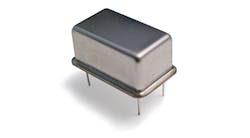Does your application require a super-stable frequency source? How about the ability of the frequency source to be fine-tuned? Sounds like a voltage-controlled crystal oscillator (VCXO) may be a great choice for your specific needs! By using a crystal oscillator as the basis of the circuit in a VCXO, high levels of frequency stability and low levels of phase noise can be maintained while still being able to control the frequency over a small range.
In this final post in our common oscillator type series, you’ll learn all the necessary basics of what VCXOs are, how they work, and what makes them so great for specific applications.
Exploring the VCXO Circuit
The basic circuit for a VCXO consists of a standard crystal oscillator, but with an electronic means of tuning or “pulling” the frequency slightly. This is almost invariably achieved by using varactor or varicap diodes. In most VCXOs, a pair of back-to-back diodes is placed across the crystal. A reverse bias is applied to anodes of the diodes, which then act as a variable capacitor across the crystal. In most cases, a Colpitts oscillator circuit is used.
The amount by which the crystal’s frequency can be pulled depends on a variety of factors. Some of these include:
- The level of capacitance applied
- The circuit’s conditions
- The crystal itself
However, the frequency cannot be pulled too far because the activity of the crystal reduces as the level of capacitance across the crystal increases. If it is necessary for the VCXO to be pulled over a large range, an inductor can be incorporated into the circuit.
VCXO Performance: Pros and Cons
Using this approach, VCXO figures of frequency variation of around 35 to 50 ppm/volts are reasonably easy to achieve and are quite common.
Naturally, the fact that the frequency of the VCXO can be pulled reduces the overall performance of the oscillator’s circuit. The phase noise performance of the oscillator is degraded because the effective Q of the resonator is considerably reduced. Additionally, the frequency stability is not as good.
One of the major problems with VCXOs is that of temperature drift. As this varies over the voltage control range, it cannot be optimized for all levels of control voltage, the final design being a compromise. When used without other forms of temperature compensation, their frequencies may drift more than other types of crystal oscillators, such as OCXOs and TCXOs.
Is Your Application in need of a VCXO?
As with all types of oscillators, VCXOs are used in many different applications. They are used in TCXOs where the temperature compensation voltage is applied to a control terminal of the VCXO. In this way the drift can be considerably reduced, although the performance is still not as good as a full oven-controlled crystal oscillator.
In other applications, VCXOs are often found in narrowband phase-locked loops where only a small amount of frequency variation is required.
7 Factors to Consider When Deciding Whether a VCXO is Best for Your Application
Many VCXOs are ordered as modules from a specialist supplier. It is necessary to specify them correctly to obtain the required product.
When specifying a VCXO, the following parameters are normally needed:
1. Frequency
This is normally specified in MHz for frequencies over 1.0 MHz and in kHz below this. It also needs to be specified to the correct number of decimal places to enable the manufacturer to be able to determine the required frequency needed. Refer to the manufacturers details for the correct number—typically six or seven significant figures.
2. Output
VCXOs are required for a number of applications. Some may be used to drive different forms of logic, whereas others may be required for analog applications. The output requirements are an important element of the overall specification.
3. Frequency Stability
Even though VCXOs are variable, the basic frequency stability still needs to be specified. Generally, this is done for room temperature, 20°C, and with the voltage control point set to its center value. The frequency stability is taken for operation over the operating temperature range. The value is specified in terms of parts per million (ppm). Standard stability specifications are typically ±25 ppm, ±50 ppm, and ±100 ppm.
4. Supply Voltage
It is necessary to specify the supply voltage to ensure that it operates within the unit for which it is intended. Ideally it should be able to operate outside the expected tolerance of the supply so that any slight mismatch does not cause an issue.
5. Operating Temperature Range
Most units have a temperature operating range over which they will function. Accordingly, it is necessary to specify a range for the VCXO. There are three main ranges:
- 0 to +70°C: Often referred to as a commercial temperature range. It is normally satisfactory for operation within office or laboratory environments.
- −10 to +70°C: Industrial range which is needed where temperature ranges may fluctuate more widely.
- −40 to +85°C: This is nearing the military range (normally −40 to +125°C) and is required where much larger temperature ranges are needed—for example, for equipment that may be used externally.
Note: There is often a temperature rise within an item of equipment. This means that components will be operating well above the ambient external temperature. This must be taken into consideration when determining what temperature range may be needed.
6. Pullability
The pullability is the frequency range over which the VCXO can be pulled for a given change in control voltage. It is specified in terms of parts per million (ppm) for a given voltage. As is expected, large pullability figures give a larger tuning range, but VCXOs with smaller levels of pullability offer greater stability and lower phase noise.
7. Package
It is necessary to specify the package, as VCXOs come in many forms and various options may be available, from through-hole mount to surface mount. Also, options such as tape and reel are often available for large-scale manufacture using automated manufacturing machinery.
With these criteria in mind, you should have no problem conversing with an oscillator supplier and determining the perfect VCXO for your application!


